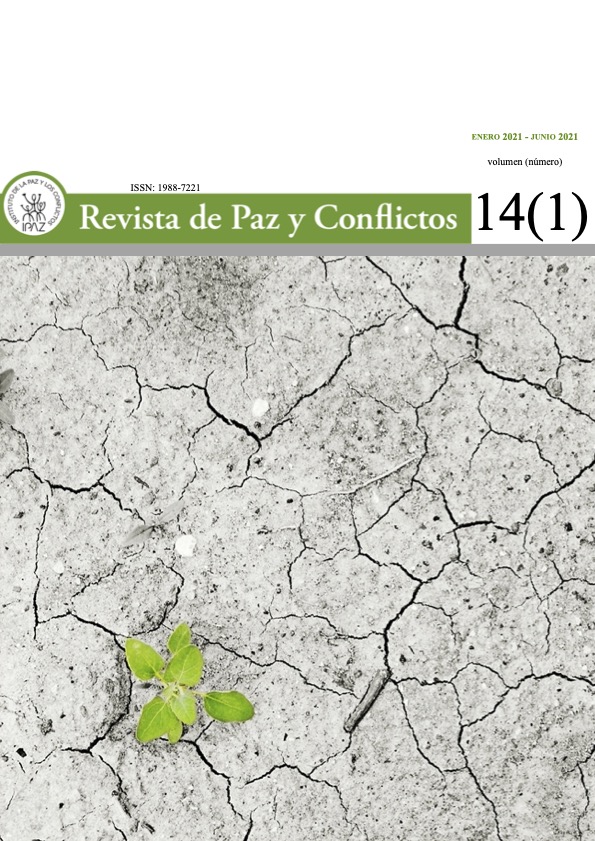Mapeo de los conflictos interamericanos desde la Segunda Guerra Mundial: una visión general de los embargos militares y económicos
DOI:
https://doi.org/10.30827/revpaz.v14i1.15218Resumen
América Latina es considerada una región políticamente turbulenta pero, después del final de las
guerras de independencia, un ambiente geopolítico relativamente pacífico. Eso está relacionado a su
distancia de los principales conflictos internacionales y el dominio consolidado de una
superpotencia sobre la región. De hecho, desde la Segunda Guerra Mundial, el papel desempeñado
por Estados Unidos es fundamental para comprender la dinámica de los conflictos en la región.
Pero, ¿este dominio ha garantizado estabilidad en la región? Para comprender la dinámica de los
conflictos en el subsistema interamericano y los posibles cambios resultantes de la transición del
sistema internacional, exploramos datos sobre conflictos interamericanos y mapeamos 55 años de
disputas económicas y militares en el continente americano. Sistematizamos las interacciones
conflictivas para identificar patrones y cambios en la interacción entre Estados Unidos y América
Latina. Presentamos evidencia de un cambio significativo en el tipo de conflicto, del militar al económico, entre la Guerra Fría y el período posterior. Nuestros hallazgos también indican un
predominio de las intervenciones militares durante la Guerra Fría, especialmente como una
respuesta de Estados Unidos a las guerras intraestatales (revoluciones y guerras civiles), dirigidas
predominantemente a países pequeños de Centroamérica y el Caribe. Después del final de la Guerra
Fría, las sanciones económicas dominaron la agenda y fueron direccionadas por Estados Unidos
principalmente a los tres países más grandes de América Latina: Brasil, México y Argentina.
Descargas
Citas
Benoit, K. (1996), Democracies Really Are More Pacific (in General): Reexamining Regime Type and War Involvement, Journal of Conflict Resolution, Vol. 40 No. 4, pp. 636–657.
Chan, S. (1984), Mirror, Mirror on the Wall...: Are the Freer Countries More Pacific?, Journal of Conflict Resolution, Vol. 28 No. 4, pp. 617–648.
CPDOC. (2017), X Conferência Interamericana, Fundação Getúlio Vargas, available at: http://cpdoc.fgv.br/producao/dossies/AEraVargas2/glossario/x_conferencia_interamericana.
DeConde, A., Burns, R.D. and Logevall, F. (Eds.). (2002), Encyclopedia of American Foreign Policy, 2nd ed., Scribner, New York.
Foreign Relations of The United States. (1953), Statement of Policy by the National Security Council, United States Department of State, 18 March, available at: https://history.state.gov/historicaldocuments/frus1952-54v04/d3.
Herz, M. (1994), Análise Cognitiva e Política Externa, Contexto Internacional, Vol. 16 No. 1, pp. 75–89.
Herz, M. (2002), Política de segurança dos EUA para a América Latina após o final da Guerra Fria, Estudos Avançados, Vol. 16 No. 46, pp. 85–104.
Hey, J.A.K. (1997), Three Building Blocks of a Theory of Latin American Foreign Policy, Third World Quarterly, Vol. 18 No. 4, pp. 631–657.
Ikenberry, G.J. and Kupchan, C.A. (1990), Socialization and hegemonic power, International Organization, Vol. 44 No. 03, p. 283.
Kisangani, E.F. and Pickering, J. (2008), International Military Intervention, 1989-2005: Version 1, ICPSR - Interuniversity Consortium for Political and Social Research, available at: https://doi.org/10.3886/icpsr21282.v1.
Livingstone, G. (2009), America’s Backyard: The United States and Latin America from the Monroe Doctrine to the War on Terror, Zed Books, London, New York.
Lowenthal, A.F. (1989), Os Estados Unidos e a América Latina: além da era Reagan, Lua Nova: Revista de Cultura e Política, No. 18, pp. 41–61.
Merke, F. and Reynoso, D. (2016), Dimensiones de política exterior en América Latina según juicio de expertos, Estudios Internacionales, Vol. 185, pp. 107–131.
Morgan, T.C., Bapat, N. and Kobayashi, Y. (2014), The Threat and Imposition of Sanctions: Updating the TIES dataset, Conflict Management and Peace Science, Vol. 31 No. 5, pp. 541–558.
O’Brien, T.F. (2007), Making the Americas: The United States and Latin America from the Age of Revolutions to the Era of Globalization, University of New Mexico Press, Albuquerque.
Pastor, R.A. (2001), Exiting the Whirlpool: U.S. Foreign Policy toward Latin America and the Caribbean, 2nd. ed., Westview Press, Boulder, Colo.
Pearson, F.S. and Baumann, R.A. (1993), International Military Intervention, 1946-1988: Version 1, ICPSR - Interuniversity Consortium for Political and Social Research, available at: https://doi.org/10.3886/icpsr06035.v1.
Pecequilo, C.S. (2011), A política externa dos Estados Unidos: continuidade ou mudança?, Editora da UFRGS, Porto Alegre.
Russett, B.M. and Oneal, J.R. (2001), Triangulating Peace: Democracy, Interdependence, and International Organizations, Norton, New York.
Smith, J. (2007), Historical Dictionary of United States-Latin American Relations, Scarecrow Press, Lanham, Md.
Taffet, J.F. (2007), Foreign Aid as Foreign Policy: The Alliance for Progress in Latin America, Routledge, New York.
Wittkopf, E.R., Jones, C.M. and Kegley, C.W. (2008), American Foreign Policy: Pattern and Process, 7th ed., Thomson/Wadsworth, Belmont, CA.
Vaisse, M. (1995), As relações internacionais desde 1945. Lisboa: Edições 70.
Descargas
Publicado
Cómo citar
Número
Sección
Licencia
Esta obra está bajo una licencia internacional Creative Commons Atribución 4.0.














